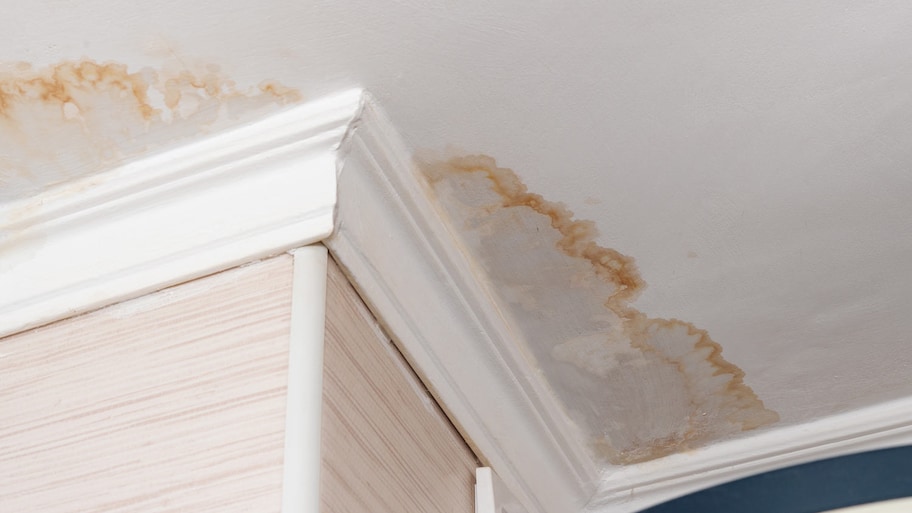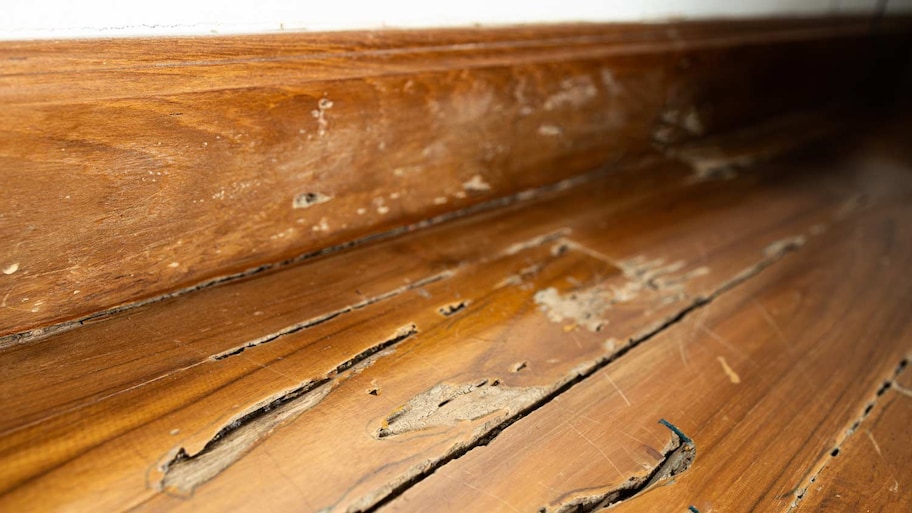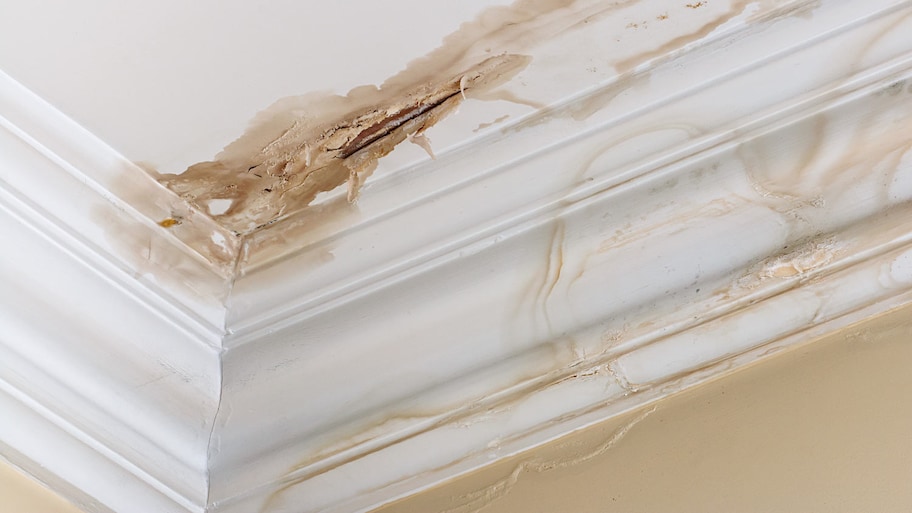What’s the Difference Between Water Damage and Termites?
Water and termites are two of wood’s biggest enemies


Highlights
Water damage usually appears as square-shaped “cells” while termite damage looks like small, round holes.
Knocking on termite-damaged wood sounds hollow while water-damaged wood sounds solid.
Bubbling or peeling paint are signs of damage that can come from both water damage and termite damage.
Professional services are needed to repair water and termite damage.
Water damage and termite damage are two things (of many) that every homeowner hopes they never have to deal with. At first glance, the signs may look similar. A deeper dive will give you the tools to uncover the root of the problem and keep your walls — and floors and ceilings — from crumbling. Keep reading as we break down the differences between water damage and termite damage so you can plan a quick, effective fix.
What Are the Differences Between Water Damage and Termite Damage?

There are similarities in the appearance of water damage and termite damage, but as a whole, both are very different. You can use four of the five senses — definitely not taste — to help identify the problem. Water damage and termite damage differ in their look (shape and color), feel, sound, and smell.
| Type of Difference | Water Damage | Termite Damage |
|---|---|---|
| Signs | Mold or fungus | Mud tunnels |
| Shape | Square-shaped “cells” | Small, round holes |
| Color | Yellow or dark | No discoloration |
| Feel | Soft and spongy | Hard |
| Sound | Solid | Hollow |
| Smell | Musty odor | No odor |
Water Damage vs Termite Damage: Differences in Appearance

It’s surprisingly easy to look at water damage or termite damage and mistake them for the alternative. Both problems can cause paint to bubble and peel away from wood, but there are a few key differences in their appearance, namely shape, color, and signs of damage, that can help you identify the issue.
Shape
Water-damaged wood is characterized by a square-shaped “cell” pattern called cubicle rot. If it’s hard to envision, imagine the scales you’d see on an alligator’s back. Also called “alligatoring,” it usually starts as slight cracks before growing into wider and deeper patterns that look like alligator skin.
If you have trypophobia, an aversion to clusters of small holes, termite damage might be two nightmares rolled into one. As termites eat their way through wood, they create small, round holes that are visible from the surface.
Color
Water damage on walls and wood can cause the areas to darken or become slightly yellow while termite damage often causes little to no discoloration.
Signs of Damage
On the walls of your home, water damage and termite damage can look identical. The behind-the-scenes damage can cause bubbling or peeling paint; however, water damage typically presents with water stains as well.
Houses are surrounded by tons of wood whether it’s in the walls, adorning a wooden entryway, or making up the landscape in the backyard. Extensive water damage on wood usually shows up as fungus and mold. Mold often grows in a circular pattern with a fuzzy appearance. When checking for mold, the color can vary, but it’ll usually be white, green, or black.
Signs of termite damage on wooden surfaces include mud tunnels. These are linear growths made up of dirt, wood, and termite droppings, or “frass,” that termites use to travel. After termites have their way with your wood, the damaged wood can become warped and appear wavy.
Differences in How They Feel
When you touch wood, the way it feels can indicate whether you’re dealing with water or termite damage.
Water damage weakens wood and its structural integrity, causing it to become soft and spongy to the touch. This can also be a result of dry rot — when airborne spores latch onto damp wood and begin growing.
Alternatively, termites also cause significant wood damage; however, if you were to touch the surface, the wood feels hard.
Sound Differences
Knocking on wood does more than keep you from jinxing yourself. It’s an easy trick to identify the type of damage you’re dealing with so you can call the right professional to fix your problem.
Water-damaged wood doesn’t have an unusual sound. It should sound solid. Because termites eat through your wood, there are likely multiple areas of wood missing. And when your wood is hollow, it’ll create a hollow sound if you knock on it.
Odor Differences
Smell is a great indicator of water damage vs. termite damage. Termite damage has no smell while water damage is characterized by a musty smell. The odor is caused by damp wood or mold growth and can be especially noticeable if the water damage is in a poorly ventilated area.
Repair Differences
Fixing water damage or termite damage often requires extensive work at the hands of qualified professionals.
Water Damage Repair
Water damage can ruin your home in the blink of an eye. Much of the damage happens behind the scenes whether it's mold growth, structural damage, or even electrical issues. Whether you spring a leak or are dealing with the aftermath of a flood, immediately stop and minimize the water damage while you contact your local water damage restoration company. Typically, you won’t want to wait until you see signs of damage as mold can start developing within 24 hours and structural damage is possible within a week.
Termite Damage Repair
The first step in repairing termite damage — get rid of the termites. It’s not a problem that’s easily solved, especially not with store-bought pest spray. Hire a termite control specialist who’ll come ready with the right chemicals and tools to exterminate them.
Depending on how long a termite colony has been eating its way through your home, the damage can vary from minimal to extensive. Minor damages can be solved with quick DIY projects that include cosmetic fixes like sanding, repainting, and refinishing. Extensive damages will require hiring a contractor to build or repair the damaged parts of your home.
If a termite infestation is affecting your trees, you’ll need to hire an arborist to conduct a tree inspection. It’s like bringing an on-call doctor to perform a check-up on your trees. They’ll check for general tree health, structural integrity, safety concerns, and of course, signs of insects or pests. When termites are caught early, it may be possible to save the tree. If not, the termites might’ve already caused enough damage to the tree and its branches, making them significantly easier to break during storms. If the arborist recommends removal, a local tree debris removal service can handle the removal and disposal of the tree for you.
Frequently Asked Questions
Yes, your home can have water and termite damage at the same time. One of the three most common termites in the United States is the dampwood termite. This pest is known for feeding on wet, rotting wood. And while they’re not the most common termite usually found in the home, they’re more likely to appear within your walls if your home has water damage.
Depending on the size of a termite colony and how quickly it matures, it can take three to five years to see visible damage. It may take five to six years to damage the home's structural integrity. Subterranean termites, which are found in all states except Alaska, are known to be particularly damaging and can cause extensive damage in as little as two years.
